An article first-authored by LLE Integrated Modeling Group Leader and Senior Scientist, Tim Collins, was selected for the cover of the January issue of Physics of Plasmas. “Causes of fuel–ablator mix inferred from modeling of monochromatic time-gated radiography of OMEGA cryogenic implosions” discusses that OMEGA cryogenic implosions backlit with OMEGA EP were performed that straddled the areal-density degradation line and allowed direct observations of fuel–ablator mix close to bang time. Synthetic backlit x-ray radiographs generated from 2D modeling of these shots with draco agreed well for both shots. For the more-unstable shot, two assumptions were needed for good agreement between modeling and experimental data. The first assumption is that imprint occurred at a higher level than expected in 2D (which is expected due to 3D effects and could also be a sign of other instability seeds, such as dust on the target, voids in the ice, etc.). Second, good agreement required simulations to assume that the ablator thickness, measured at 11.2±0.3 µm, was 11.5 µm at the upper limit of the measured range. This may reflect a thick ablator (but one within the range of uncertainty for target metrology) or may be a sign of discrepancies between the modeled and actual ablation rates. Future backlit experiments could leverage this observation by using targets characterized with higher precision as a sensitive test of ablation physics.
Publications
LLE Article Featured on the Cover of Physics of Plasmas

Physics of Plasmas cover with LLE's Tim Collins and LLE co-authors C. Stoeckl, R. Epstein, W. A. Bittle, C. J. Forrest, V. Yu. Glebov, V. N. Goncharov, D. R. Harding, S. X. Hu, D. W. Jacobs-Perkins, T. Z. Kosc, J. A. Marozas, C. Mileham, F. J. Marshall, S. F. B. Morse, P. B. Radha, S. P. Regan, B. Rice, T. C. Sangster, W. T. Shmayda, M. J. Shoup III, C. Sorce, W. Theobald, and M. D. Wittman
